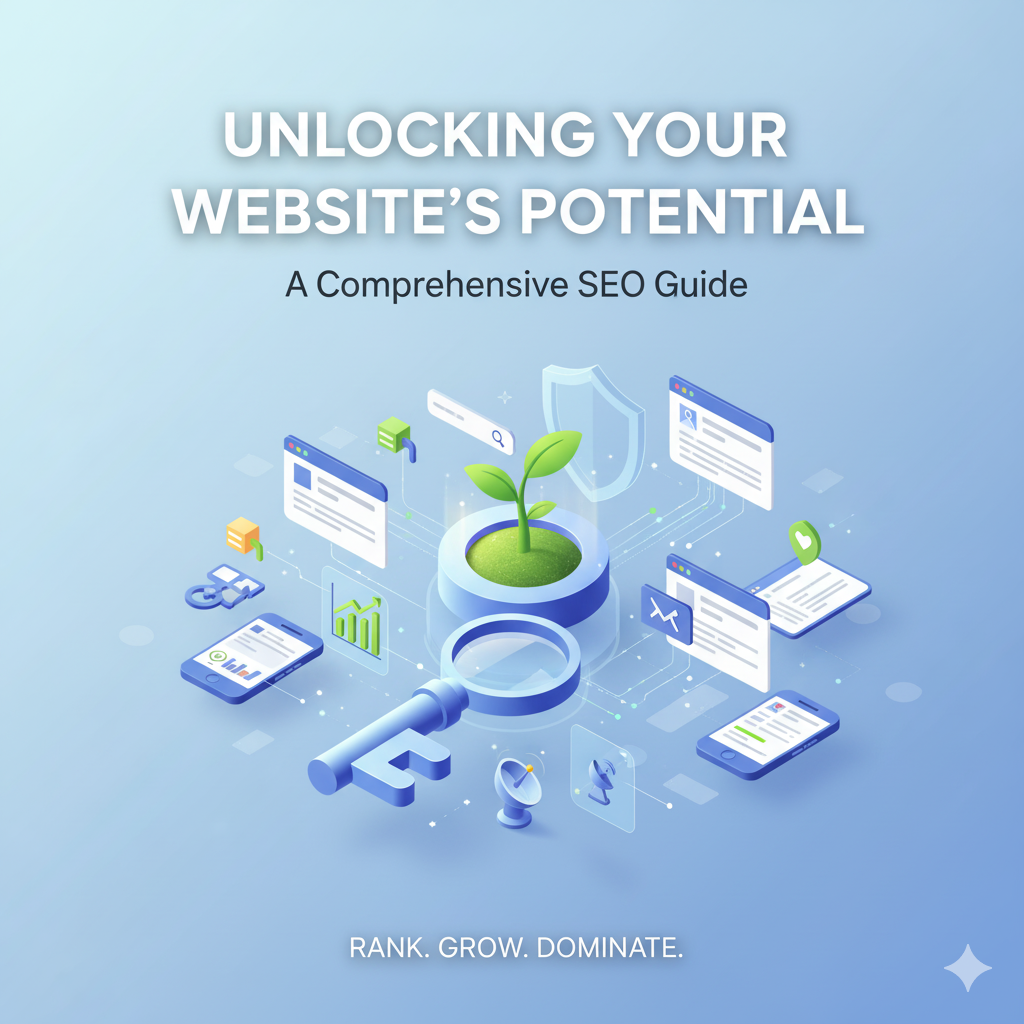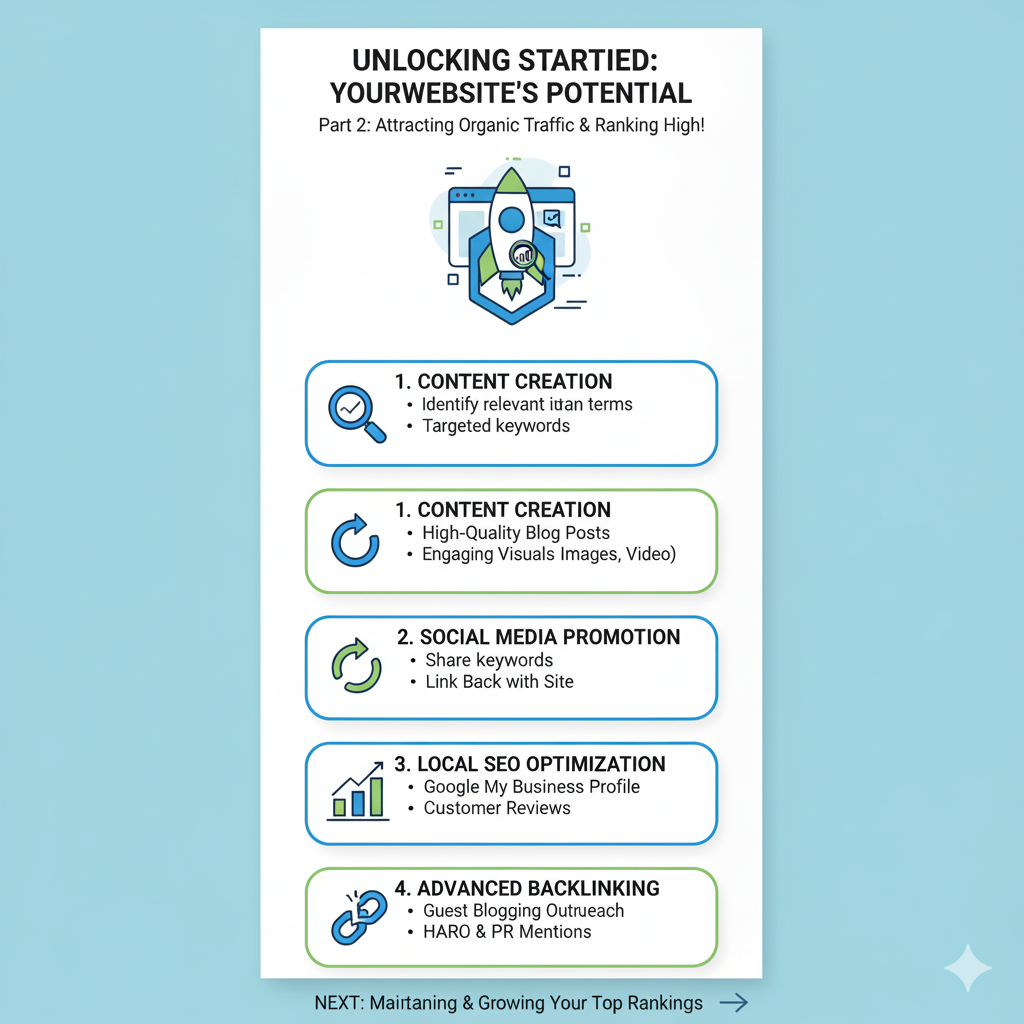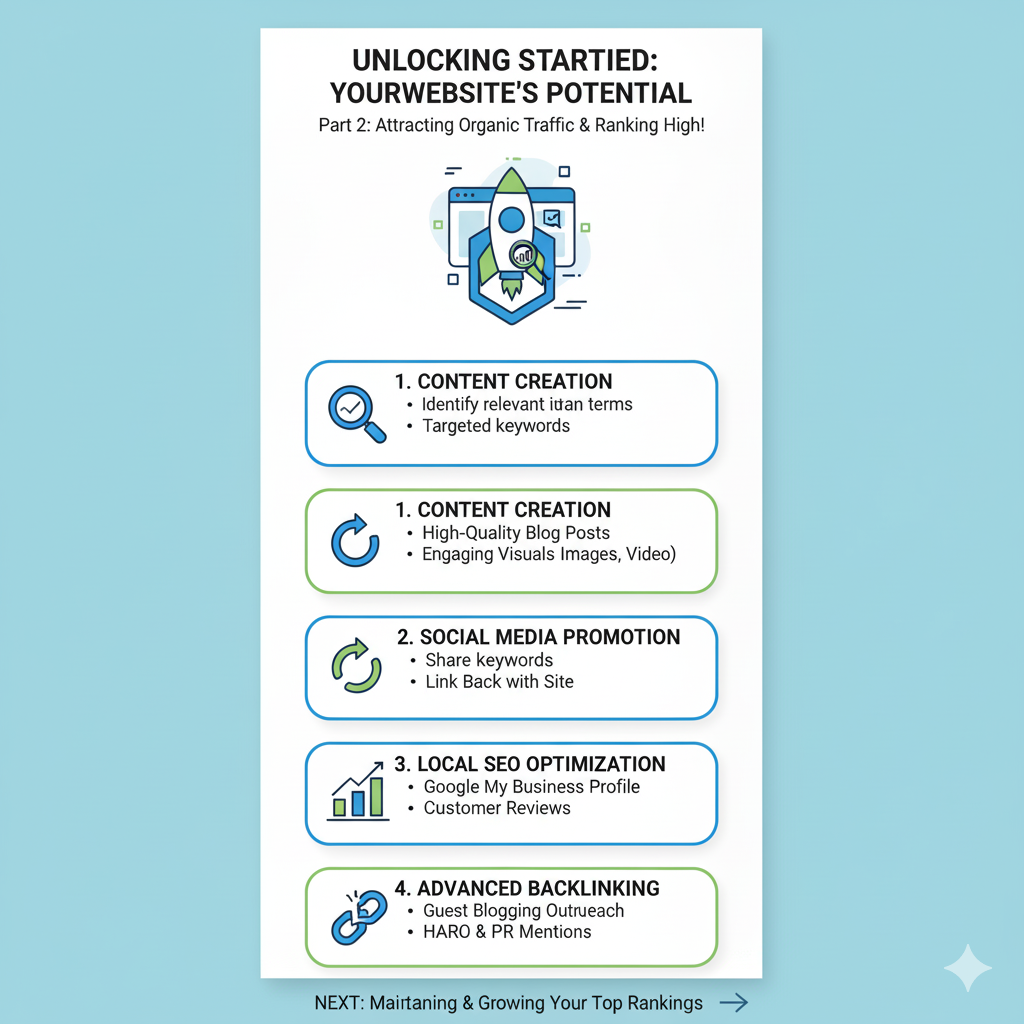
So, you’ve launched your brand-new website – congratulations!
This is an exciting milestone, but the journey to online visibility has just begun.
In today’s crowded digital landscape, simply existing isn isn’t enough.
To truly thrive, your website needs to be discovered by your target audience, and that’s where Search Engine Optimization (SEO) comes into play.
Think of SEO as your website’s compass, guiding potential visitors directly to your digital doorstep.
But what exactly is SEO, and how do you navigate its complexities, especially with a fresh domain?
More importantly, what happens after you’ve put in the hard work and started ranking for your desired keywords?
Do you simply sit back and enjoy the traffic?
Not quite. SEO is an ongoing process, a marathon, not a sprint.
In this comprehensive guide, we’ll explore the fundamental SEO strategies for new websites and delve into advanced tactics to employ once you’ve secured those coveted top spots in search engine results.

Videos are added as random thoughts 💭 💭 💭 💭
Part 1: Laying the Foundation – SEO Strategy for New Websites
Building a strong SEO foundation from day one is crucial for long-term success.
Here are the essential steps to get your new website noticed by search engines and potential customers.
1. Set Up the Essentials: Making Your Site Visible to Search Engines
Before anything else, you need to ensure search engines can actually find, crawl, and index your website.
Without this crucial step, all your other SEO efforts will be in vain.
As Isaac Church, Director at 3WH, emphasizes,
“There’s literally no point fixing anything if Google can’t even see the site” [1].
Create a `robots.txt` file: This file tells search engine crawlers which pages they can and cannot access on your site.
Ensure it doesn’t block any important pages you want to rank.
Set up Google Search Console (GSC): This free tool from Google is indispensable.
It allows you to monitor your site’s performance in Google Search, identify indexing issues, submit sitemaps, and see which keywords are driving traffic.
Submit an XML Sitemap: An XML sitemap lists all the important pages on your website, helping search engines discover and crawl your content more efficiently.
Generate one and submit it through Google Search Console.
Implement Google Analytics 4 (GA4): GA4 helps you understand user behavior on your site – where they come from, what they click, and which pages are most engaging. This data is vital for refining your SEO strategy.
Consider AI Visibility Monitoring Tools: With the rise of AI platforms like ChatGPT and Gemini, monitoring your visibility in these new search experiences is becoming increasingly important [1].
2. Master Keyword Research: Understanding Your Audience’s Language
Keyword research is the cornerstone of any successful SEO strategy.
It involves identifying the words and phrases your target audience uses when searching for information, products, or services related to your business.
For new websites, the focus should be on finding low-competition, long-tail keywords.
Start with Google Keyword Planner: This free tool, while primarily for Google Ads, is an excellent starting point for SEO keyword research.
Enter a broad term related to your niche to get a list of keyword ideas, along with average monthly searches and competition levels [1].
Focus on Long-Tail Keywords: These are more specific, often longer phrases (e.g.,
“best vegan restaurants in downtown Austin” instead of “vegan restaurants”).
They typically have lower search volume but also lower competition and higher conversion rates, making them ideal for new sites to gain initial traction [1].
Identify Search Intent: Understand why someone is searching for a particular keyword.
Are they looking for information (informational), trying to buy something (transactional), or navigating to a specific website (navigational)? Align your content with this intent.
3. Create High-Quality, People-First Content: Value Over Volume
Google and other search engines prioritize content that is helpful, reliable, and user-focused.
Your content needs to deliver genuine value and offer something unique to stand out.
High-quality content is also more likely to appear in AI-powered search experiences [1].
Satisfy Search Intent: Directly answer the user’s query.
If they’re looking for a guide, provide a comprehensive one. If they want to buy, offer clear product information and calls to action.
Incorporate Real Expertise and Experience: Share insights derived from direct experience or deep subject knowledge.
This builds trust and authority. Use examples, case studies, and personal anecdotes.
Speak to Your Audience: Use language and examples that resonate with your readers. Make your content engaging and easy to understand.
Include Visuals: Break up text with images, infographics, charts, and short videos. Visuals improve readability and can help explain complex concepts [1].
Offer Original Research or Insights: Differentiate your content by conducting small-scale experiments, surveys, or sharing unique data. This adds significant value and can attract backlinks.
4. Optimize Technical SEO: Ensuring a Smooth User Experience
Technical SEO refers to website and server optimizations that help search engine spiders crawl and index your site more effectively.
A technically sound website also provides a better user experience, which indirectly boosts your rankings.
Site Speed and Mobile-Friendliness: Ensure your website loads quickly on all devices, especially mobile.
Google uses Core Web Vitals (Largest Contentful Paint, First Input Delay, Cumulative Layout Shift) as ranking factors [2].
Use tools like Google PageSpeed Insights to identify and fix issues.
Secure Your Site with HTTPS: An SSL certificate encrypts data between the user’s browser and your website, making it secure. HTTPS is a ranking signal and builds user trust.
Implement Schema Markup (Structured Data): Schema markup helps search engines understand the context of your content, leading to rich snippets in search results (e.g., star ratings, product prices).
This can increase click-through rates.
Optimize Site Structure: Create a logical and intuitive website hierarchy. Use clear navigation, internal linking, and breadcrumbs to help users and search engines understand your site’s organization.
5. Master On-Page SEO: Optimizing Individual Pages
On-page SEO involves optimizing elements on your web pages to rank higher and earn more relevant traffic.
This includes optimizing your content and HTML source code.
Compelling Title Tags: Your title tag is the first thing users see in search results. Make it descriptive, include your primary keyword, and keep it under 60 characters to avoid truncation.
Engaging Meta Descriptions: While not a direct ranking factor, a well-crafted meta description can significantly improve click-through rates.
Summarize your page’s content and include a call to action, keeping it under 160 characters.
Strategic Heading Tags (H1, H2, H3): Use heading tags to structure your content logically. Your H1 should contain your primary keyword and accurately reflect the page’s topic. H2s and H3s break up content and can include related keywords.
Internal Linking: Link to other relevant pages within your website. This helps distribute “link equity,” improves user navigation, and signals to search engines the relationships between your content.
Image Optimization: Use descriptive alt text for images (for accessibility and SEO), compress images for faster loading, and use relevant file names.
6. Build High-Quality Backlinks (Off-Page SEO): Earning Authority
Off-page SEO refers to actions taken outside of your website to impact your rankings.
The most critical aspect of off-page SEO is building high-quality backlinks – links from other reputable websites to yours.
Backlinks act as “votes of confidence” from other sites, signaling to search engines that your content is valuable and authoritative.
Guest Blogging: Write articles for other relevant websites in your niche, including a link back to your site in your author bio or within the content.
Broken Link Building: Find broken links on other websites, create content that replaces the missing resource, and suggest your content as a replacement.
Content Promotion: Share your content on social media, reach out to influencers, and participate in online communities to increase its visibility and attract natural backlinks.
Competitor Backlink Analysis: Use tools to analyze your competitors’ backlink profiles and identify opportunities to earn similar links.
Part 2: Beyond Ranking – What to Do Once You’ve Secured Top Spots

Congratulations! You’ve put in the work, and your website is now ranking for some of your target keywords. But the work doesn’t stop here.
In fact, this is where the real challenge begins: maintaining and improving your rankings while fending off competitors.
Here’s what to do once you’ve achieved those coveted top spots.
1. Service Secondary Content Opportunities and Expand Topical Authority
Now that you’re ranking for your primary keywords, it’s time to broaden your horizons.
Think of it like a successful restaurant that’s famous for its burgers – now it’s time to perfect the fries and milkshakes [2].
Target Secondary Keywords: Identify and target keywords that are related to your primary keywords but may have slightly lower search volume.
These can still bring in valuable traffic and conversions.
Expand Your Product/Service Offerings: If you’re an e-commerce site, consider adding complementary products. If you’re a service-based business, think about offering related services.
Build Topical Authority: Google rewards websites that demonstrate deep expertise in a particular subject.
Create a comprehensive content hub around your core topics, covering all related subtopics and questions.
This signals to search engines that you are an authority in your field [2].
For example, if you sell running shoes, you could create content about different running techniques, injury prevention, marathon training, and nutrition for runners.
2. Make Time for Technical Improvements and Conversion Rate Optimization (CRO)
With your primary keywords performing well, you now have the breathing room to focus on technical enhancements and optimizing your website for conversions.
Conduct a Technical SEO Audit: Regularly audit your website for technical issues that could be hindering performance.
Use tools like Google Search Console and Semrush’s Site Audit to identify and fix problems like broken links, crawl errors, and duplicate content [2].
Focus on Core Web Vitals: Continuously monitor and improve your Core Web Vitals (Largest Contentful Paint, First Input Delay, and Cumulative Layout Shift).
A fast, responsive website provides a better user experience and can lead to higher rankings [2].
Optimize for Conversions (CRO): Getting traffic is only half the battle.
The ultimate goal is to convert that traffic into customers or leads.
Conversion Rate Optimization (CRO) involves testing different elements of your website –
such as headlines, calls to action, button colors, and form fields – to see what resonates best with your audience and drives the most conversions.
Use A/B testing to make data-driven decisions [2].
3. Compare with Competitors and Stay Ahead of the Curve
SEO is a competitive landscape.
Even if you’re at the top, your competitors are constantly working to dethrone you.
A thorough competitive analysis can help you stay one step ahead.
Analyze Competitor Strategies: Identify what your competitors are doing well.
What keywords are they targeting?
What kind of content are they creating?
What is their backlink profile like?
Use this information to identify gaps in your own strategy and find new opportunities.
Monitor SERP Changes: Search engine results pages (SERPs) are constantly evolving, with new features like AI-powered overviews, featured snippets, and local packs.
Monitor these changes and adapt your strategy to take advantage of new opportunities.
4. Update and Refresh Existing Content
Your existing content is a valuable asset. Don’t let it become stale.
Regularly update and refresh your top-performing content to keep it relevant and accurate.
Identify Underperforming Content: Use Google Analytics to identify pages with high traffic but low engagement or conversion rates.
Update this content with fresh information, new visuals, and a stronger call to action.
Add New Information: Has there been new research or developments in your industry? Update your content to reflect the latest information.
Improve Readability: Break up long paragraphs, add bullet points and subheadings, and use a clear and concise writing style.
Conclusion
SEO is a dynamic and ever-evolving field.
For new websites, the initial focus should be on building a strong technical foundation, conducting thorough keyword research, and creating high-quality, user-focused content.
Once you’ve achieved some initial success and started ranking for your target keywords, the focus shifts to maintaining and improving your position, expanding your topical authority, and optimizing for conversions.
By following the strategies outlined in this guide, you can not only get your new website ranked but also build a sustainable, long-term SEO strategy that drives organic traffic and grows your business for years to come.
References
[1] [How to Do SEO for a New Website: 7 Essential Steps]()
[2] [Five Things to Do for SEO When You Already Rank #1]()
